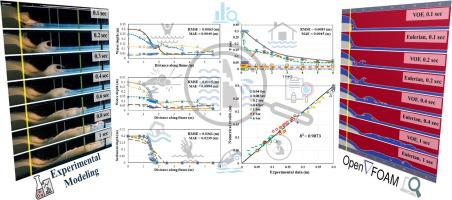当前位置:
X-MOL 学术
›
J. Hydrol.
›
论文详情
Our official English website, www.x-mol.net, welcomes your
feedback! (Note: you will need to create a separate account there.)
Experimental Study and Numerical Verification of Silted-Up Dam Break
Journal of Hydrology ( IF 5.9 ) Pub Date : 2020-11-01 , DOI: 10.1016/j.jhydrol.2020.125267 Foad Vosoughi , Gholamreza Rakhshandehroo , Mohammad Reza Nikoo , Mojtaba Sadegh
Journal of Hydrology ( IF 5.9 ) Pub Date : 2020-11-01 , DOI: 10.1016/j.jhydrol.2020.125267 Foad Vosoughi , Gholamreza Rakhshandehroo , Mohammad Reza Nikoo , Mojtaba Sadegh

|
Abstract In this study, multiphase flood waves caused by failure of silted-up dams have been scrutinized experimentally, and efficacy of the public-domain CFD software OpenFOAM numerical models to represent such phenomenon is evaluated. Experimental observations are sparse on dam break for reservoirs with high sediment depths, called silted-up reservoirs. Sediment layer, in this case, may behave as a viscous fluid and produce a complex multi-layer flow of air and water overtopping a sediment layer. Massive sediment quantities can have a substantial impact on the wave propagation pattern caused by dam break. This study contributes to an experiment-based understanding of dam break phenomenon with silted-up reservoir, and elaborates the propagation of multi-layer waves. Herein, different hydraulic conditions were experimentally observed including 8 different upstream sediment depths in the range of 0–0.24 m and 4 downstream initial water levels of 0, 0.02, 0.04 and 0.05 m, which collectively created 32 scenarios. The resulted waves were filmed by high-speed cameras and data were extracted through image processing. An open-source CFD software, namely OpenFOAM, was employed to simulate the experiments using two distinct numerical approaches: volume of fluid (VOF) and Eulerian. Results of both numerical approaches were in good agreement with the experimental measurements; with MAE and RMSE error values varying from 0.006 m to 0.031 m and 0.008 m to 0.043 m, respectively (2% to 10% and 2.6% to 14% with respect to the reservoir height of 0.3 m). The Eulerian approach showed marginally superior performance to VOF, especially in cases with high sediment depths, which is likely due to accommodating phase mixing. A wide collection of high-quality data is made available online in the Appendix Data and could be utilized in future studies.
中文翻译:

淤塞溃坝试验研究与数值验证
摘要 在这项研究中,对淤塞大坝破坏引起的多相洪水波进行了实验研究,并评估了公共领域 CFD 软件 OpenFOAM 数值模型代表这种现象的有效性。对于沉积物深度较高的水库(称为淤积水库),在溃坝时的实验观察很少。在这种情况下,沉积层可能表现为粘性流体,并在沉积层上方产生复杂的多层空气和水流。大量沉积物可能对溃坝引起的波浪传播模式产生重大影响。本研究有助于对淤塞水库的溃坝现象进行基于实验的理解,并阐述了多层波的传播。在此处,实验观察了不同的水力条件,包括上游 0-0.24 m 范围内的 8 个不同沉积物深度和 0、0.02、0.04 和 0.05 m 的 4 个下游初始水位,共创建了 32 个场景。产生的波由高速摄像机拍摄,并通过图像处理提取数据。使用开源 CFD 软件 OpenFOAM 来模拟实验,使用两种不同的数值方法:流体体积 (VOF) 和欧拉。两种数值方法的结果与实验测量结果非常一致;MAE 和 RMSE 误差值分别从 0.006 m 到 0.031 m 和 0.008 m 到 0.043 m 不等(相对于 0.3 m 的储层高度,分别为 2% 到 10% 和 2.6% 到 14%)。欧拉方法表现出略优于 VOF 的性能,特别是在沉积物深度较高的情况下,这可能是由于相混合所致。附录数据中在线提供了大量高质量数据,可用于未来的研究。
更新日期:2020-11-01
中文翻译:

淤塞溃坝试验研究与数值验证
摘要 在这项研究中,对淤塞大坝破坏引起的多相洪水波进行了实验研究,并评估了公共领域 CFD 软件 OpenFOAM 数值模型代表这种现象的有效性。对于沉积物深度较高的水库(称为淤积水库),在溃坝时的实验观察很少。在这种情况下,沉积层可能表现为粘性流体,并在沉积层上方产生复杂的多层空气和水流。大量沉积物可能对溃坝引起的波浪传播模式产生重大影响。本研究有助于对淤塞水库的溃坝现象进行基于实验的理解,并阐述了多层波的传播。在此处,实验观察了不同的水力条件,包括上游 0-0.24 m 范围内的 8 个不同沉积物深度和 0、0.02、0.04 和 0.05 m 的 4 个下游初始水位,共创建了 32 个场景。产生的波由高速摄像机拍摄,并通过图像处理提取数据。使用开源 CFD 软件 OpenFOAM 来模拟实验,使用两种不同的数值方法:流体体积 (VOF) 和欧拉。两种数值方法的结果与实验测量结果非常一致;MAE 和 RMSE 误差值分别从 0.006 m 到 0.031 m 和 0.008 m 到 0.043 m 不等(相对于 0.3 m 的储层高度,分别为 2% 到 10% 和 2.6% 到 14%)。欧拉方法表现出略优于 VOF 的性能,特别是在沉积物深度较高的情况下,这可能是由于相混合所致。附录数据中在线提供了大量高质量数据,可用于未来的研究。











































 京公网安备 11010802027423号
京公网安备 11010802027423号